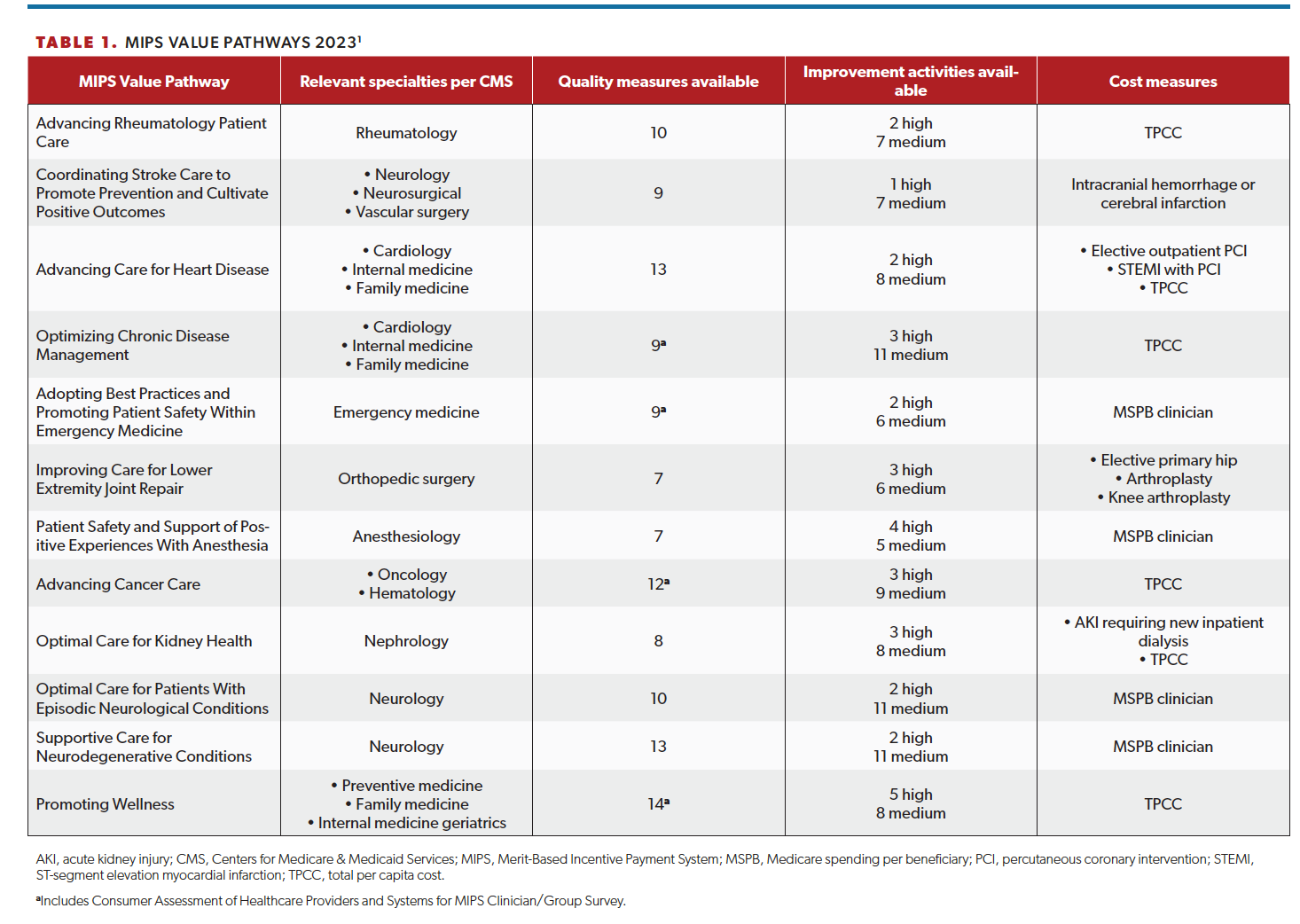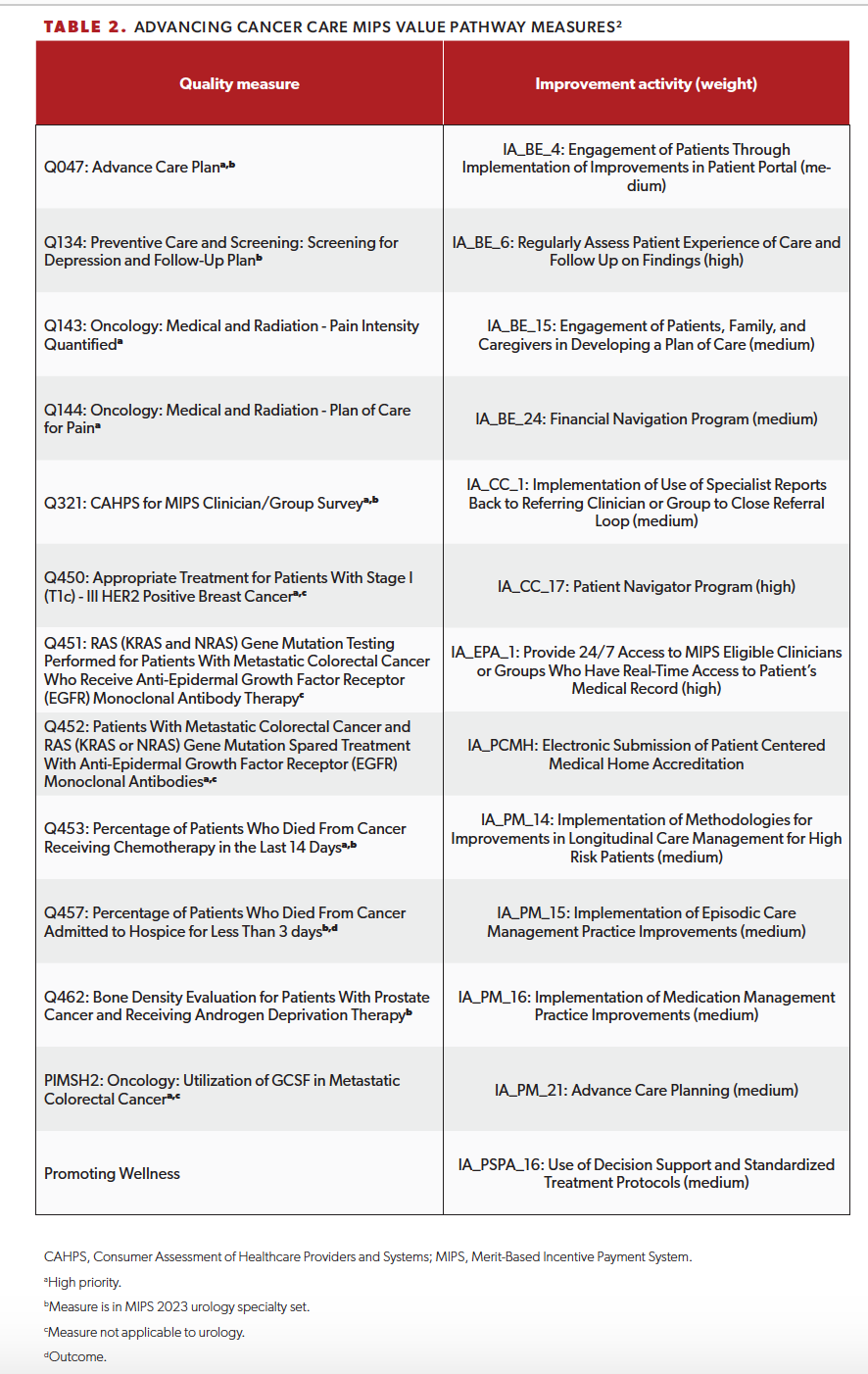Publication
Article
Urology Times Journal
Move over, MIPS: MIPS Value Pathways are coming
Author(s):
Urologists should watch early adopters of MVPs to know what to expect.
Robert A. Dowling, MD

If you’re familiar with the genealogy of Medicare reimbursement systems, you might recognize this ancestral line: Physician Quality Reporting Initiative begat Physician Quality Reporting System, who married meaningful use and was adopted by the Merit-Based Incentive Payment System (MIPS) and alternative payment models. It’s certainly more than one busy clinician can keep track of, but there’s a new member of the family: MVPs. It doesn’t stand for “most valuable players” but rather MIPS Value Pathways. I know you were just getting used to MIPS (also known as the “most impenetrable perplexing scheme”) after 6 years, but they are moving the cheese. In this article, I’ll tell you what you need to know about the MVP option as we understand it today—and why.

MVPs were conceived several years ago as a response to feedback that the traditional MIPS was complicated and burdensome and that many specialties (including urology) did not have relevant measures, resulting in an inability to compare similar clinicians. MVPs are best thought of as a specialty—a condition-specific reporting structure that would standardize the measures being reported—theoretically forming the basis for reduced reporting burdens, meaningful comparisons, and relevant feedback to participants. The first 12 MVPs were rolled out for implementation in 2023 (Table 11) and are most relevant to 15 specialties, but none of them are urology. Although MVPs are not restricted to those specialties, from a practical standpoint, they may not be feasible for clinicians of other specialties because of the activities needed to support the available measures. MVPs are currently voluntary, but we can watch the early adopters with interest and anticipate the eventual rollout of urology MVPs. And here is the punch line: The Centers for Medicare & Medicaid Services (CMS) intends to sunset the traditional MIPS in the future and make MVPs mandatory.2 So pay attention. All MVPs share a common structural paradigm: All clinicians must report the same measures in the Promoting Interoperability category as they did in the traditional MIPS. In addition, for 2023, all MVP participants must choose
1 of 2 population health measures: Measure 479: Hospital-Wide, 30-Day, All-Cause Unplanned Readmission (HWR) Rate for the Merit-Based Incentive Payment System (MIPS) Groups or Measure 484: Clinician and Clinician Group Risk-Standardized Hospital Admission Rates for Patients With Multiple Chronic Conditions. The data to calculate these public health measures are obtained from claims (no reporting required), and the measure is included as part of the quality category for scoring. Each MVP has a set of quality measures and improvement activities tailored to the specialty or condition addressed by the MVP. Participants must choose 4 quality measures (instead of 6 in the traditional MIPS), and these must include 1 outcome measure. For the improvement activity category, participants can choose 2 medium- or
1 high-weighted activity from the MVP list (instead of 4 medium- or 2 high-weighted activities or 1 high- and 2 medium-weighted activities). The cost category of each MVP contains relevant measures to the condition or specialty. As with the traditional MIPS, the data are collected from claims. Because of this, participants in MVPs have a reduced burden for reporting quality measures and attesting to improvement activities, the same reporting considerations for Promoting Interoperability, and similar cost measures compared with the traditional MIPS.1

What about scoring? Remember that MVP is primarily a reporting paradigm; scoring is almost identical to that of the traditional MIPS. There same 4 categories exist, and they are given the same weight. Quality measures are scored on a benchmarking system (if benchmarks are available), and bonus points are awarded for complex patients as in the traditional MIPS. One important difference from the traditional MIPS is that clinicians can register as part of a subgroup and be scored at the subgroup level. For example, a large multispecialty group may have a subgroup that chooses a cardiology MVP, another that chooses an oncology MVP, a third that chooses a rheumatology MVP, and several clinicians who do not choose any MVP. CMS will calculate MIPS scores for the individual, the group, and the MVP subgroups and award the highest of these as the final MIPS score.
How do you sign up for an MVP? As an individual or group, you need to register between early April and late November of the reporting year and select an MVP and population health measure. If you elect to create a subgroup, you will need to provide CMS with a list of the members, a name, and a description of the subgroup. More detail is available in the implementation guide online.1
Can urologists report as MVPs? Although there is no official urology MVP yet, some urology individuals or groups could theoretically consider the Advancing Cancer Care MVP, primarily tailored to medical oncology and hematology. Six of the 12 quality measures are actually in the urology specialty set of MIPS, and several improvement activities in this MVP could easily be attested to by urologists (Table 21).
It is unclear to this author whether patients could be attributed to urologists for either of the population health measures. Although urologists are not usually scored on this MVP’s cost measure—total per capita cost—because of attribution rules, CMS has stated they will reweigh this category under certain circumstances: “If the affiliated group can’t be scored on any of the cost measures, the subgroup’s cost performance category will be reweighted to 0% and its weight will be redistributed to other performance categories.”1 In short, it might be feasible for urologists to report under this MVP.
What would a true urology MVP look like? Upon the common foundation of Promoting Interoperability measures and the population health measure, we might see a set of 10 quality measures that relate to common conditions: prostate cancer, stone disease, and lower urinary tract symptoms (processes and outcomes). The Consumer Assessment of Healthcare Providers and Systems Clinician & Group Survey is a standardized measure of patient experience with care of acute and chronic conditions that could be included as an option for a urology MVP. The same generic improvement activities in the Advanced Cancer Care MVP would be appropriate for urology. Finally, the best cost measure, which is already developed, could be the Renal or Ureteral Stone Surgical Treatment episode-based measure. This combination of measures relevant to urology and reduced reporting burden could be a meaningful step forward in linking value to reimbursement.
The Bottom Line and Why It Matters
CMS has stated its intention to sunset the traditional MIPS and move to MVPs. MVPs are to some extent a reorganization of MIPS categories and measures to encourage clinicians to report and be held accountable along specialty or condition lines, which they have been clamoring for. MVPs require fewer measures and ease the reporting burden. Just as in the early days of the traditional MIPS, however, specialties such as urology do not yet have MVP options to participate in the new paradigm. The core reason for this is the unavailability of mature and relevant quality measures in the specialty and the MIPS. Until that changes, MVP may stand for more of a “minimally viable product” for urologists than a “more valuable paradigm.”
References
1. Merit-Based Incentive Payment System (MIPS): 2023 Merit-Based Incentive Payment System (MIPS) Value Pathways (MVPs) implementation guide. Centers for Medicare & Medicaid Services. Accessed December 14, 2022. bit.ly/3IXsuaN
2. Transition from traditional MIPS to MVPs. Centers for Medicare & Medicaid Services. Accessed December 14, 2022. bit.ly/3iQjnhx

Newsletter
Stay current with the latest urology news and practice-changing insights — sign up now for the essential updates every urologist needs.





























